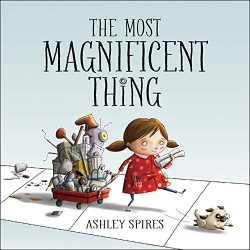The Most Magnificent Thing
The Most Magnificent Thing: Overview and Description

Plot
This story is about a young engineer and her attempts to build something magnificent. With help (or not) from her assistant (a pug dog), she sketches plans, gathers supplies, and makes multiple attempts to assemble the magnificent thing she hopes to create. Overcoming frustration and engineering failures, she perseveres to make something magnificent that both she and her assistant can enjoy together.
Math Practice (Perseverance)
This story is a powerful opportunity to observe a young engineer as she travels through the iterative process and experiences big feelings! When a mathematician tinkers, experiments, revises, and “fails”, they can feel everything from inspiration to frustration. After all, it takes perseverance to create something magnificent! Through this story, we can explore questions such as: What does it feel like to experiment with ideas? When does it feel exciting to try something new? When might it feel frustrating? Why does this young engineer explode? Have you ever felt like you were going to explode? What strategies does this engineer use to keep going? How can we learn how to be a mathematician who perseveres?
Math Content
There are always opportunities to explore math content in stories. For example, in this book, you might pause on a page where the young engineer has her inventions laid out on the sidewalk and ask, “How many inventions do you see? How did you count them?” Children ages 12 to 24 months may use words such as “a lot” or “so many” as they develop number concepts. Children ages 2 to 3 years may count the objects as they point to the page saying, “one, two, three” or use words such as “first” and “last”. Children who are 4 to 5 years old may see the items in groups and add on, saying “here is three (as they circle three items clustered on the page and count on) four, five, six….”. Or, perhaps you explore the shapes of the inventions, asking, “What shapes do you notice?” and “Where do you see them?” Young children may use shape names, such as squares, circles, triangles, and rectangles. As well as words to describe spatial relationships, such as behind, in front of, next to, and on top or beneath. Exploring ideas about number and shape are exciting in this story as we think about ALL the things the young engineer creates, and the big emotions of iteration, as she strives for something magnificent!
Read Alouds: Let’s Read Together
Try one (or all) of the three read alouds provided below.
Open Notice and Wonder Read
Enjoy a first read where you follow children’s interest, pausing where there is energy to ask, What do you notice? and/or What do you wonder? Celebrate hearing children’s ideas!
Math Lens Read
A math lens read can go back to revisit what children noticed and wondered mathematically during the first read! You may or may not read entirely through or perhaps jump to focal parts of the story to think as mathematicians. For example, to think about the math practice of perseverance, you might say, “You noticed the young engineer felt frustrated! Let’s go back and think about what happened that led to her feeling big feelings!” OR, to think about math content and number, you might pause on the page where she has her inventions lined up on the sidewalk and invite young mathematicians to count, “How many inventions do you see? How did you count them?”
Story Explore Read
A story explore read can go back to revisit what children noticed and wondered about the story during the first read! You may or may not read entirely through or perhaps jump to focal parts of the story to think as readers. For example, you might say, “You noticed the young engineer had lots of different feelings as she worked to create the most magnificent thing. For example, at one point in the story she had a swirling cloud of anger and frustration above her head! Have you ever felt this way? Why? What did you do to feel differently or become less frustrated? Let’s do a picture walk back through the story to keep track of all the different feelings the young engineer had in the story.
